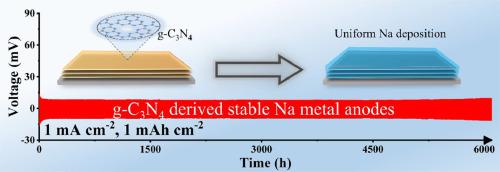Energy Storage Materials ( IF 20.4 ) Pub Date : 2023-04-28 , DOI: 10.1016/j.ensm.2023.102793 Jin Wang , Zhixiao Liu , Baihua Qu , Zhipeng Li , Yiming Zhang , Chunliu Xu , Zhao Chen , Qingshui Xie , Ming-Sheng Wang , Miao Lu , Junmei Zhao , Jingfeng Wang , Dong-Liang Peng , Fusheng Pan , Yong-Sheng Hu

|
Sodium (Na) metal has been considered as promising anode materials for next generation high-energy-density Na-based batteries due to its high theoretical capacity, abundant resources and low cost. However, the unstable electrode/electrolyte interface caused by side reaction and dendrite growth usually results in unsatisfying cycling lifespan of Na metal batteries. Herein, an ionic-electronic dual-conducting interlayer with N-rich sites is constructed upon Na metal anode by an in situ reaction between metallic Na and graphitic carbon nitride (g-C3N4). Benefiting from the strong absorption to Na+, the abundant N-sites in interlayer can form transient Na-N bonds to stabilize the electrode/electrolyte interphase for uniform Na nucleation and growth. Meanwhile, the ionic-electronic dual-conducting interlayer contributes to gradient and uniform Na deposition. As a result, the Na symmetric cells can be cycled stably for an exceptionally prolonged over time of 6000 h with a much lower voltage hysteresis at 1 mA cm−2. Moreover, the full cells paired with the constructed Na anode and Na3V2(PO4)3 cathode show an outstanding capacity retention of 96.2% after 1200 cycles at 3 C (while a sharp decay after 760 cycles for bare Na anodes). It is believed that this work provides a rational interface design that stimulates further large-scale utilization of Na metal batteries.
中文翻译:

g-C3N4原位衍生的离子-电子双导电中间层,具有富氮位点,用于长寿命钠金属阳极
钠(Na)金属由于其高理论容量、丰富的资源和低成本而被认为是下一代高能量密度钠基电池的有前途的负极材料。然而,由副反应和枝晶生长引起的不稳定的电极/电解质界面通常导致钠金属电池的循环寿命不令人满意。在此,通过金属 Na 和石墨碳氮化物 (gC 3 N 4 )之间的原位反应,在 Na 金属阳极上构建了具有富 N 位点的离子电子双导电夹层。受益于对 Na +的强烈吸收,层间丰富的 N 位点可以形成瞬态 Na-N 键,以稳定电极/电解质界面,实现均匀的 Na 成核和生长。同时,离子电子双导电夹层有助于梯度和均匀的钠沉积。因此,Na 对称电池可以稳定地循环 6000 小时,并且在 1 mA cm -2时具有低得多的电压滞后。此外,全电池与构建的 Na 阳极和 Na 3 V 2 (PO 4 ) 3配对阴极在 3 C 下 1200 次循环后显示出 96.2% 的出色容量保持率(而裸钠阳极在 760 次循环后急剧衰减)。相信这项工作提供了一种合理的界面设计,可以刺激钠金属电池的进一步大规模利用。



























 京公网安备 11010802027423号
京公网安备 11010802027423号